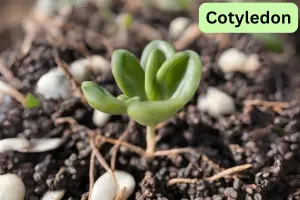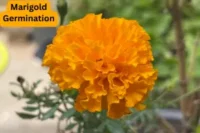What is Seed Epigeal Germination? A Beginner-Friendly Guide for Students and Gardeners
Published: 28 Jan 2025
Hello, Young Botanist! 😎
Did you know that some plants lift their seed leaves above the soil as they grow? This fascinating process is called seed epigeal germination, where the cotyledons rise above the ground, helping the plant access sunlight more efficiently.
Sheila, the author of this article, holds a master’s degree in botany and seven years of research experience. This article explores seed epigeal germination, its process, characteristics, and practical tips for gardeners to identify and nurture such plants.
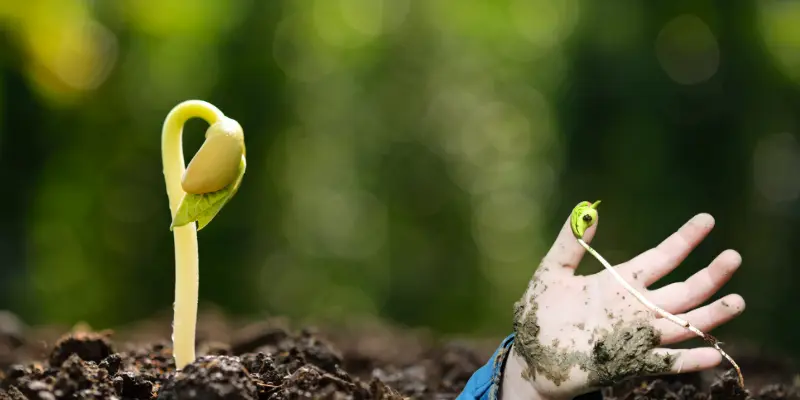
By the end, you’ll gain a clear understanding of epigeal germination and actionable insights to enhance your gardening skills. Let’s discover how this process plays a key role in plant life—think of it as unlocking nature’s step-by-step guide to thriving seedlings!
What is Seed Epigeal Germination?
Epigeal germination is when a plant’s cotyledons rise above the soil as the hypocotyl elongates, allowing them to capture sunlight and fuel early growth. This process is vital for photosynthesis and plant survival, adapting seedlings to thrive in various conditions.
Each seed is a tiny vessel of hope, carrying the promise of growth and renewal.✨Frances Hodgson Burnett
From my botany experience, observing epigeal germination feels like watching nature’s story unfold, highlighting plants’ resilience and ability to thrive in diverse environments.
How Does Epigeal Germination Work?
Epigeal germination is a fascinating process where a seed transitions from dormancy to a thriving seedling. It’s like a story unfolding, each chapter revealing a new growth stage.
Let’s explore the step-by-step journey of this remarkable transformation.
Step-by-Step Process of Epigeal Germination
- Seed absorbs water and swells: The seed absorbs water and expands. This crucial process softens the seed coat and prepares it for germination.
- Radicle emerges and forms the root system: The first part of the seed to emerge is the radicle, the root. It anchors the seedlings into the soil, providing stability and access to water and nutrients.
- Cotyledons rise above the soil surface: As the hypocotyl elongates, it lifts the cotyledons (the seed leaves) above the soil. These cotyledons act like solar panels, soaking up sunlight to fuel the seedling’s growth.
- First, true leaves develop: The true leaves form after the cotyledons. These leaves are more specialized for photosynthesis, helping the plant produce energy for its continued growth and development.
This process highlights nature’s strength and reminds me that understanding and appreciation grow steadily over time, like plants.
The greatest wonder of gardening is seeing life rise from the soil, reaching for the sun.Liberty Hyde Bailey
Characteristics of Epigeal Germination
- Epigeal germination stands out for its unique traits, making it fascinating to observe and understand. Each characteristic contributes to the seedling’s early survival and growth.
- As a gardener, I’ve often marvelled at how these traits showcase the adaptability and resilience of plants—like nature’s way of giving seedlings a head start in life. Let’s explore these defining features.
1. Position of Cotyledons
One striking feature of epigeal germination is how the cotyledons emerge above the soil, acting as tiny solar panels to kickstart photosynthesis.
Watching bean seedlings in my garden always feels like a small miracle.
2. Rapid seedling growth
Seedlings with epigeal germination grow quickly as they push their cotyledons upward. This rapid development helps them adapt to their environment, ensuring they capture light and resources early.
It’s like a race where the seedling sprints to secure its place in the sun.
3. Environmental Adaptation
Plants with epigeal germination thrive where light is readily available, as their exposed cotyledons rely on photosynthesis for energy. For example, beans and cotton flourish in well-lit environments.
I’ve noticed that these plants perform best when grown in nutrient-rich soil with good sunlight exposure, a tip every gardener should remember.
Examples of Plants with Epigeal Germination
When learning about epigeal germination, looking at real-life examples of plants that undergo this process is helpful. These plants show the unique features of epigeal germination and are great examples for gardeners and students.
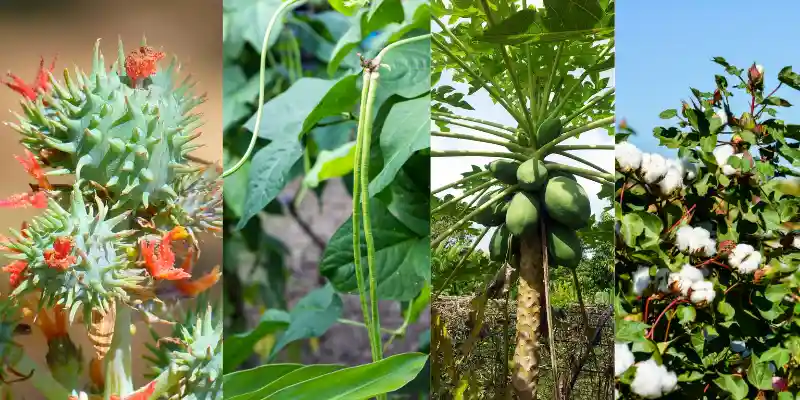
These examples make the process easier to understand, like recognizing familiar sights in a new place.
Common Examples for Students and Beginners
Here are some common examples of epigeal-germinated plants:
| Plant | Description |
| Beans | A classic example of epigeal germination. The seed leaves rise above the soil, making it easy for beginners to observe. It is ideal for students as they germinate quickly. |
| Castor | Castor plants show clear epigeal germination with large, glossy cotyledons above the soil—a great example for gardeners and students. |
| Papaya | Papaya seeds undergo epigeal germination, with cotyledons emerging above the soil, perfect for observing the process in tropical environments. |
| Cotton | Cotton plants exhibit epigeal germination. Their adaptability to dry conditions is an interesting aspect of their growth process. |
Differences Between Epigeal and Hypogeal Germination
Knowing the differences between epigeal and hypogeal germination is essential for anyone studying plant growth. While both processes lead to a seedling, they follow different paths and behaviours.
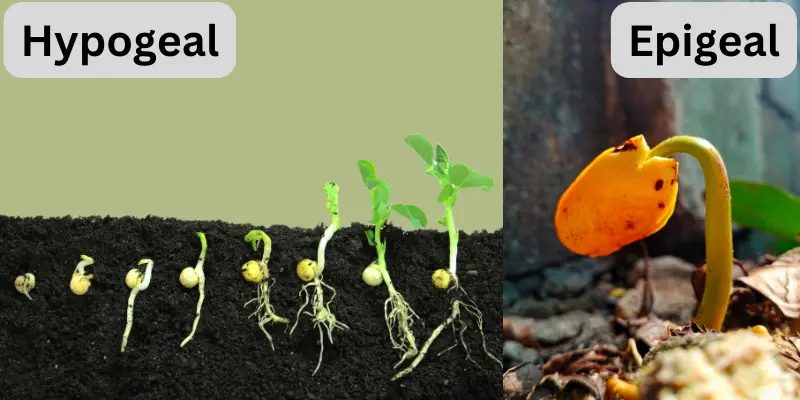
Think of it as comparing two routes to the same destination, each with its unique approach and benefits.
| Aspect | Epigeal Germination | Hypogeal Germination |
| Position of cotyledons | Cotyledons rise above the soil, capturing sunlight. | Cotyledons remain below the soil, focusing on root growth. |
| Growth dynamics of seedlings | Seedlings grow rapidly, with cotyledons emerging above the soil. | Seedlings grow slowly, prioritizing root development first. |
| Examples | Beans, Cotton | Peas, corn |
Why is Epigeal Germination Important for Gardeners?
Understanding epigeal germination is important for gardeners because it affects how seedlings grow and how to care for them successfully. Learning how epigeal germination works provides you with the knowledge needed to successfully nurture your plants, just as knowing the rules of a game helps you play better.
With this knowledge, you may establish the optimal climate for developing seeds and guarantee a plentiful harvest.
Benefits of Growing Plants with Epigeal Germination
Let’s study the benefits of epigeal germination
Faster Growth and Early Photosynthesis
- Epigeal germination allows seedlings to quickly push their cotyledons above the soil, exposing them to sunlight for early photosynthesis. This faster growth means you can expect your plants to develop soon, giving you an earlier harvest.
- I’ve seen this firsthand with beans in my garden, where the seedlings seem to burst forth, ready to start their journey toward maturity.
To nurture a seedling is to witness the triumph of life over all odds.Audrey Hepburn
Improved Seedling Strength
- As epigeal plants grow quickly and develop their cotyledons above the soil, they often exhibit stronger seedlings. This process helps them become hardier and better able to withstand environmental challenges.
- I’ve found that epigeal plants like cotton are resilient and adapt well to different growing conditions.
Tips for Nurturing Seedlings Effectively
You can apply the mentioned tips for better growth of your garden:
Provide Adequate Light
- Since epigeal seedlings rely on their cotyledons to start photosynthesis, ensure they receive plenty of light.
- A sunny spot or grow lights can work wonders for giving them the best start.
Water Regularly but Gently
- Water is essential for the initial stages of germination. To prevent the young roots from drowning, ensure the soil is consistently moist but not soaked.
- In my experience, light misting works best for keeping seedlings happy.
Protect from Harsh Conditions
- Extreme conditions can harm young epigeal seedlings. Shield them from strong winds and harsh sunlight until they’re well-established.
- I often place my seedlings in a shaded area for the first few weeks to allow them to adapt.
Factors Affecting Epigeal Germination
The right environment and quality seeds ensure successful epigeal germination. Like building a strong house with a solid foundation, managing these factors ensures your plants thrive.
I’ve seen how minor changes, such as boosting soil quality or ensuring adequate sunlight, can greatly enhance seedling growth.
Let’s study each factor and its impacts on epigeal germination:
| Factors | Details | Tips/Insights |
| Light | Cotyledons need adequate light for photosynthesis after emergence. | Place seedlings in bright sunlight or use grow lights for indoor setups. |
| Water | Seeds require water to activate germination, but excess water can cause rot. | Keep soil moist but avoid overwatering; light, even watering works best. |
| Temperature | Warm soil is crucial for efficient germination. | Use a soil thermometer to ensure optimal temperature, especially in cooler months. |
| Soil Condition | Loose, nutrient-rich soil supports cotyledon emergence and root growth. | Avoid compacted soil; mix compost or organic matter for better quality. |
| Soil quality | Viable and healthy seeds are essential for successful germination. | Avoid compacted soil; mix compost or organic matter for better quality. |
How to Identify Epigeal Germination in Your Garden?
Identifying epigeal germination in your garden is easier than you might think. These seedlings exhibit unique traits that set them apart from other types.
Think of it like recognizing a friend in a crowd by their distinctive features—once you know what to look for, it becomes second nature.
Observable Traits in Seedlings
Epigeal seedlings display distinct characteristics that make them easy to recognize. Focusing on these traits lets you quickly identify their germination type in your garden.
Cotyledons Above the Soil
- The most defining feature of epigeal germination is cotyledons emerging above the soil.
- They act as the first visible leaves, often larger and rounder than the true leaves that follow.
Rapid Early Growth
- Epigeal seedlings grow quickly, with noticeable elongation of the stem (hypocotyl) as it pushes the cotyledons upward.
- I’ve seen this rapid growth in my beans, where seedlings stretch toward the sun within days.
Visible True Leaves Soon After
- After the cotyledons appear, true leaves quickly develop, signalling the seedling’s readiness for photosynthesis and continued growth.
Tips for Beginners to Spot and Care for Epigeal Seedlings
Look for cotyledons emerging above the soil as a sign of epigeal germination. Provide ample sunlight, moisten the soil, and offer gentle support to encourage healthy growth.
Observe Early Growth Stages
- Check your garden frequently in the first week after planting to observe the emergence of cotyledons above the soil. This is a clear sign of epigeal germination.
Provide Proper Support
- Since the stem grows rapidly, it may need some support to prevent bending or breaking. Adding gentle staking can help.
Ensure Adequate Light
- Place seedlings where they can get sufficient sunlight to promote healthy cotyledon and leaf development.
| Common Mistakes and How to Avoid Them |
|---|
|
Conclusion
So, guys, it’s time to wrap up. In this article, we’ve covered seed epigeal germination in plants in detail. Epigeal germination offers a unique insight into plant growth, and observing it can be both educational and fun.
I recommend growing beans or castor plants—they’re beginner-friendly and great examples of this germination type.
| Interesting Facts |
|---|
|
Frequently Asked Questions
These FAQs provide clear, beginner-friendly guidance to help readers better understand seed epigeal germination:
Cotyledons rise above the soil in epigeal germination, while in hypogeal germination, they stay below the soil. The main difference lies in how the seed stores and uses its energy. Plants like beans show epigeal germination, while peas exhibit hypogeal.
Cotyledons may struggle to emerge if seeds are planted too deep, causing weak or stunted seedlings. Plant seeds at a depth of two to three times their size for best results. This helps ensure smooth growth and prevents unnecessary stress on the seedling.
Yes, you can! Use small pots or seed trays with good-quality soil and place them in a sunny spot. Beans are an excellent choice for indoor observation.
This could be due to weak stems caused by insufficient light or overwatering. Place your seedlings in a brighter spot and ensure the soil isn’t waterlogged. Providing gentle support with stakes can also help.
Depending on the plant and conditions, the cotyledons usually take 7–10 days to emerge above the soil. Warmer temperatures and proper watering can speed up the process. Be patient and monitor your seedlings closely!

- Be Respectful
- Stay Relevant
- Stay Positive
- True Feedback
- Encourage Discussion
- Avoid Spamming
- No Fake News
- Don't Copy-Paste
- No Personal Attacks



- Be Respectful
- Stay Relevant
- Stay Positive
- True Feedback
- Encourage Discussion
- Avoid Spamming
- No Fake News
- Don't Copy-Paste
- No Personal Attacks
